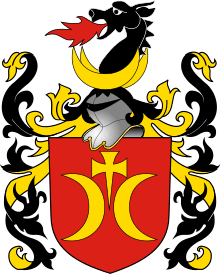Jan z Jani

Jan z Jani (Joannes de Janie in Medieval Latin,[1] Jan von der Jane in German) (1400–1461) - of the Clan of Ostoja was the first Polish Duke of Pomerelia (from 1454 to 1461) and one of the leaders of the Prussian Confederation, serving as a commander in the Thirteen Years' War (1454–66). He was also the Lord of Regality of Tczew, Nowe County and Kiszewskie, Lord of Starogard Gdański, Rabelnaw, Robaw, Pancze, Wonental, Szwarczenwalt, Weisenwalt, Moealwalt, Landesende, Turze, and Swierczyn in Pomerelia, and Lord of Gniew.[2]
Jan z Jani's origin was from a Dutch noble family[3] that entered the Clan of Ostoja through marriage with the sister of Mikołaj Szarlejski, who was part of the Clan of Ostoja and Duke of Inowrocław and Kujawy, Lord of Bydgoszcz, and member of the Prussian Confederation.[4] Together with Szarlejski, Jan z Jani raised army units in Pomerania during Thirteen Years' War (1454–66) and the conflict with Teutonic Knights. He also cooperated with another member of the Clan of Ostoja, Stibor of Poniec, Lord of Regality of Greater Poland and the renowned diplomat[5] in order to raise funds to attack Malbork, the headquarters of the Teutonic Knights.
Jan z Jani and his family were owners of the property of Świerczyn that in year 1447 belonged to Jenchen de Świerczyn.[6] This line of the family took their name from Świerczyn and called themselves the Ostoja Świerczynski. A local legend speaks of the mighty knight Jan z Jani who designed a new coat of arms and called it the Ostoja.
See also
References
- ↑ Note that Jan z Jani was originally of Dutch ethnic origins and this form of the name is a Medieval/Renaissance-era Latinized form of a Dutch name altered by the macaronic influence of vernacular French, then the lingua franca throughout Europe. During the reign of French Kings Philip the Bald and Charles the Bold, and the expansion of the Holy Roman Empire's influence throughout the European continent (especially eastward), documents were written in a language that unified Latin and French with local vernaculars (including Dutch). See: Van der Schaar, J., Woordenboek van Voornamen: inventarisatie van de doop- en roepnamen met hunetymologie. (Utrecht & Antwerpen: Aula-Boeken, 1967); For more information on this Latin-vernacular onamastic and etymological shifts, see Wright, Roger. Latin and the Romance Languages in the Early Middle Ages. (London, New York: Routledge, 1991); and Late Latin and Early Romance in Spain and Carolingian France. (Liverpool: F. Cairns, 1982).
- ↑ Seweryn Uruski, Rodzina, Herbarz szlachty polskiej, T.5, page 344 (electronic p. 348)
- ↑ Karol Górski, Studia i szkice z dziejów Państwa Krzyżackiego, Olsztyn 1986, ISBN 83-7002-229-4, str. 2 (str.18 umk)
- ↑ Zyglewski Zbigniew. Późnośredniowieczne urzędy i urzędnicy w powiecie bydgoskim. Urzędnicy ziemscy – starostowie, burgrabiowie [w.] Prace Komisji Historii Bydgoskiego Towarzystwa Naukowego. T.16. Bydgoszcz jako ośrodek administracyjny na przestrzeni wieków. Zbiór studiów pod red. Zdzisława Biegańskiego i Włodzimierza Jastrzębskiego. Bydgoszcz 1998
- ↑ Antoni Eckstein, Historia Ponieca do połowy XVI wieku, Roczniki Historyczne, T.II, str.92, IH PAN, 1926
- ↑ IHPAN, Institute of History of Polish Academy of Science, Dzierzno
Further reading
- Marian Biskup, Wojny Polski z Zakonem Krzyżackim 1308-1521, Gdańsk 1993.
- Tomasz Jurek, Dzieje Średniowieczne, Warszawa, Wydawnictwa Szkolne i Pedagogiczne, ISBN 83-02-07370-9
- Karol Górski, Pomorze w dobie wojny trzynastoletniej, Poznan 1932